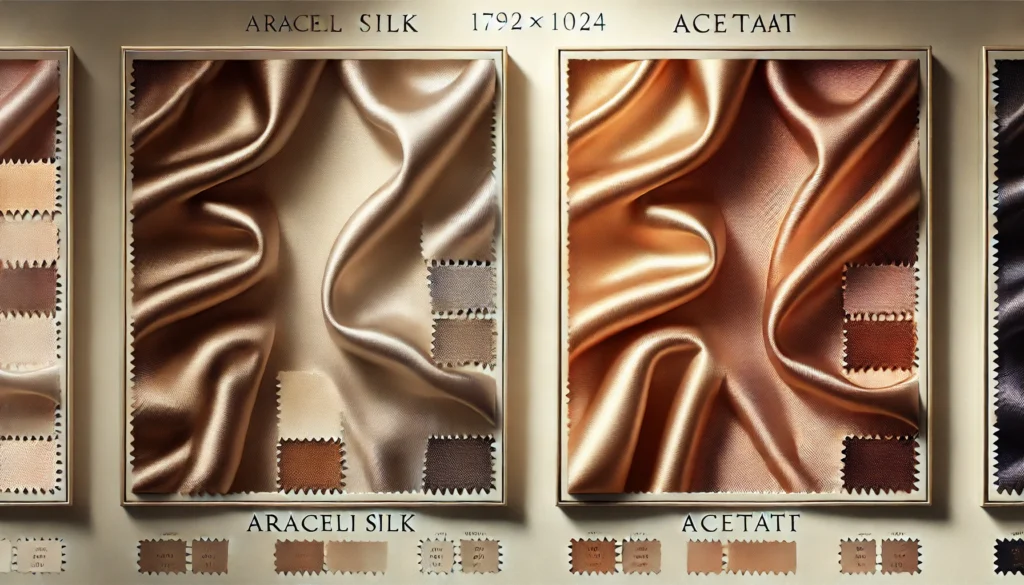When it comes to selecting the perfect fabric for your clothing or home decor, you may find yourself choosing between Araceli silk or acetat. These two materials have distinct characteristics, advantages, and disadvantages that make them suitable for different occasions and needs. This guide will help you navigate the differences between the two fabrics, from their origins and characteristics to their sustainability and cost-effectiveness.
History and Origin of Araceli Silk and Acetat
Before diving into the properties of these fabrics, it’s helpful to understand their backgrounds. Araceli silk has been a prized material for centuries, originating from the natural fibers produced by silkworms. This fabric has been used historically in luxury garments, tapestries, and even currency in ancient cultures due to its smooth texture and natural sheen.
On the other hand, acetat (commonly known as acetate) is a more modern innovation. Developed in the early 20th century, acetate is a semi-synthetic fabric made from cellulose fibers derived from wood pulp. It was created as an affordable alternative to silk, designed to mimic the look and feel of natural silk without the high cost.
Characteristics of Araceli Silk
Araceli silk is renowned for its luxurious texture and natural properties. Here are some of the key characteristics that make it unique:
- Natural Fiber: Derived from the cocoons of silkworms, making it a sustainable and biodegradable fabric.
- Breathability: Silk is highly breathable, making it ideal for both warm and cool weather. It helps regulate body temperature, keeping you cool in the summer and warm in the winter.
- Hypoallergenic: Silk is less likely to cause skin irritation, making it an excellent choice for those with sensitive skin or allergies.
- Durability: When cared for properly, Araceli silk can last for years without losing its luster or softness.
- Natural Sheen: The fabric’s natural sheen gives it a sophisticated and elegant appearance, often associated with luxury and high-end fashion.
Characteristics of Acetat
Acetat is designed to mimic the luxurious qualities of silk but at a more affordable price. Despite being semi-synthetic, it has several attractive features:
- Smooth Texture: Acetat has a smooth, silky feel that closely resembles natural silk.
- Glossy Finish: Its glossy appearance makes it ideal for evening wear, linings, and fashion pieces where shine is desirable.
- Lightweight: Acetat is lightweight, making it suitable for warm-weather clothing or garments that need to drape well.
- Affordability: Compared to Araceli silk, acetat is much more affordable, making it a budget-friendly option for many projects.
- Less Durable: One downside is that acetat is less durable than silk and can wrinkle easily or be damaged by heat.
Comparative Analysis of Araceli Silk and Acetat in Different Climate Conditions
Choosing between Araceli silk or acetat depends heavily on the climate and occasion. Here’s how these fabrics compare:
- Hot Weather: Araceli silk, with its breathable properties, excels in warm climates. Its natural ability to wick away moisture keeps you feeling cool and comfortable. Acetat, while lightweight, does not breathe as well and can trap heat, making it less ideal for hot weather.
- Cool Weather: Both fabrics perform reasonably well in cooler weather, but silk has the edge due to its natural temperature-regulating properties. It can insulate your body warmth, keeping you cozy.
- Everyday Wear vs. Special Occasions: For formal or special events, Araceli silk is often preferred because of its luxurious feel and appearance. Acetat is more suitable for casual or occasional wear, especially when budget is a consideration.
Sustainability and Ethical Production Practices
Sustainability has become a key consideration for many consumers today. When deciding between Araceli silk or acetat, it’s important to consider the environmental impact of each fabric.
- Araceli Silk: As a natural fiber, silk is biodegradable and has a relatively low environmental footprint. However, silk production involves the use of silkworms, which raises ethical concerns for some consumers. There are cruelty-free options, such as “peace silk,” which allows the silkworm to mature and leave the cocoon before it is harvested.
- Acetat: While acetat is derived from natural cellulose, the production process involves chemicals, making it less eco-friendly. The environmental impact of these chemicals can be significant, contributing to pollution. However, acetat is often seen as a more sustainable choice compared to fully synthetic fabrics like polyester or nylon.
Innovative Uses of Araceli Silk and Acetat in Modern Fashion
Both Araceli silk and acetat are used widely in modern fashion, though they serve different purposes. Silk remains the fabric of choice for high-end designers creating luxury garments, including evening gowns, scarves, and bridal wear. Its timeless elegance makes it a staple in couture.
Acetat, on the other hand, is frequently used in everyday fashion for linings, dresses, and even costumes. Its affordability and ability to hold dye well make it a popular choice for bold, vibrant designs. Fashion designers often use acetat to achieve a silk-like appearance in garments without the hefty price tag.
Long-Term Cost vs. Short-Term Cost: An Investment Perspective
When comparing Araceli silk or acetat, cost is a major factor. Silk is a long-term investment. Although it’s more expensive upfront, its durability and timeless style mean it can be worn for years, making it a cost-effective option over time. Acetat, while cheaper initially, tends to wear out faster and may need replacing sooner.
From an investment perspective, if you’re looking for something that will last and retain its luxurious appearance, Araceli silk is worth the higher price. Acetat is better suited for short-term projects or garments that won’t be worn frequently.
Consumer Reviews and Opinions on Araceli Silk and Acetat
Consumers generally praise Araceli silk for its comfort, breathability, and elegant appearance. It is often regarded as a luxury fabric, but one that requires careful maintenance. On the other hand, users appreciate acetat for its affordability and convenience, though they acknowledge its tendency to wrinkle and its sensitivity to heat.
Both fabrics have their loyal followers, with many consumers choosing silk for special occasions and acetat for more casual or budget-conscious needs.
Caring for Araceli Silk and Acetat
Proper care is essential to extend the life of your garments, whether they are made from Araceli silk or acetat.
- Araceli Silk:
- Hand wash with cold water or use a delicate cycle in the washing machine.
- Use a mild detergent designed for silk.
- Avoid wringing the fabric; instead, press gently to remove excess water.
- Lay flat to dry, away from direct sunlight.
- Store silk garments in a cool, dry place to avoid damage.
- Acetat:
- Dry clean for best results.
- If washing at home, use cold water and a gentle detergent.
- Avoid high heat when ironing as acetat is heat-sensitive.
- Store acetat garments by hanging them to prevent wrinkles.
Conclusion: Which Fabric is Best for You?
Ultimately, the choice between Araceli silk or acetat depends on your needs, budget, and how you plan to use the fabric. If you’re looking for luxury, breathability, and durability, Araceli silk is the ideal choice. It’s perfect for special occasions or garments that require a touch of elegance. However, if you’re working with a tighter budget or need a fabric for casual wear or short-term use, acetat offers a silk-like alternative at a fraction of the cost.
Both fabrics have their strengths, and understanding the properties of Araceli silk or acetat will help you make the best choice for your project or wardrobe.


